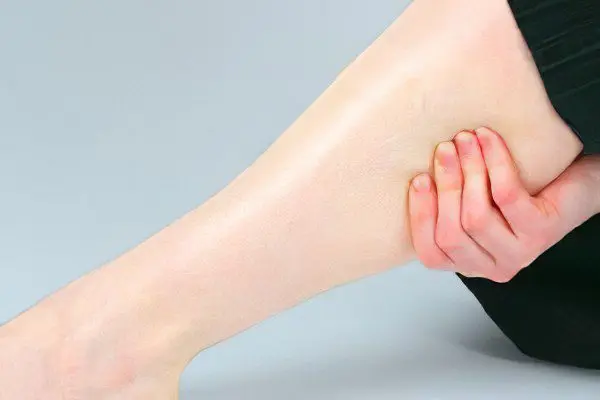Contents

Most often, pain in the joints, calf muscles and legs is due to the presence of inflammatory diseases of the veins. This category includes thrombophlebitis and phlebitis. The development of varicose veins, which is accompanied by a pronounced dilatation of the veins, is a typical symptom of these diseases.
Causes of pain in the veins
Often on the legs, varicose veins appear in people who, due to their profession, have to walk or stand a lot. This condition is accompanied by swelling, severe pain, dysfunction. The patient feels heaviness in the legs, which does not allow to sleep peacefully at night. It is worth noting that such symptoms are most often manifested in women – this is due to individual predisposition, a certain type of vein structure, and pregnancy.
If the patient notes with the first sign that the vein on the leg hurts, then, most likely, a thrombosis of the vessel has occurred. The outflow of blood is disturbed and because of this, a large amount of it remains in the veins, contributing to the stretching and expansion of the vessel wall. There are two networks of the venous system of the lower extremities: a deep venous network and a superficial one. Most of the blood flows through the deep vein system, and superficial veins take part in the removal of blood from the skin.
Pain in the veins in the legs during thrombosis is observed due to compression of the tissues by a stretched vessel. The patient feels pain of a dull nature and there is a feeling that the veins in the legs are “pulling”. People with dilated veins in their legs usually get tired quickly. With prolonged standing or walking, they feel pain in the veins, tension and numbness in the legs, in some cases, their feet swell. On the shins, due to circulatory disorders, ulcers are often formed, which are quite difficult to treat.
Pain in the veins can also provoke thrombophlebitis of superficial veins. This disease is an inflammation of the vein wall, along with which a blood clot forms in its lumen. Any superficial vein can be affected. The main complaint in this case is pain in the veins.
Deep vein thrombosis in many cases can go unrecognized and be asymptomatic. This disease occurs in more than half of patients who are bedridden for a long time and in the same number of patients with paralysis of the lower extremities. Deep vein thrombosis has classic symptoms: fever of the limb, tenderness on palpation, edema, dilation of superficial veins, pain in the veins. Gomans’ symptom (pain in the calf muscle that begins with dorsiflexion of the foot) is nonspecific.
Clinical signs of the disease are distinguished by their unreliability: objective studies in half of patients with a classic picture of thrombosis do not confirm the diagnosis. There are also reverse cases: proven thrombosis in half of the cases can be asymptomatic.
Causes of dysfunction of the veins in the legs
Violations in the work of the veins in the legs can also be provoked by other reasons – a long sitting position, an uncomfortable posture while sitting, lifting and carrying heavy loads, hormonal disorders, being overweight, uncomfortable shoes. People who are tall are more prone to varicose veins. Also at risk are young mothers and women during pregnancy. It was during pregnancy that many began to show varicose veins.
Even if you wear special compression stockings all the time, there is still a chance that the situation will worsen after childbirth. There are certain symptoms that you should pay attention to: pain and swelling in the legs (especially in the afternoon), itching along the veins, night cramps, a feeling of heaviness in the legs, “manifestation” of spider veins and veins in the legs (with advanced cases – the appearance of trophic ulcers and nodes). If you feel constant heaviness in the legs, pain in the veins in the legs for several days, or swelling of the feet and lower legs, tingling and burning in the muscles, you should immediately consult a doctor.
Relief of vein pain
Varicose veins, without special therapeutic measures prescribed by a competent doctor, will not go away. However, there are certain ways to minimize discomfort and relieve pain. Avoid standing still for a long time in one place. In the affected vessels without physical activity, blood stagnates, pressure increases. It is necessary to change the position of the body, move regularly. It is also worth wearing special medical stockings or tights.
If you need to sit for a long time, then to maintain blood flow, it is worth bending and unbending the legs at the ankle joint. It is better to take a bath in the evenings. But the first step, of course, should be to see a doctor. Only he can prescribe the necessary course of treatment.









